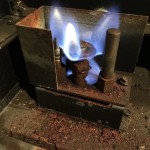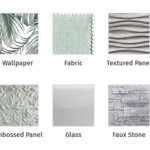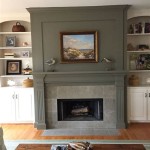Fireplace Mantel Design Ideas: Enhancing the Heart of Your Home
The fireplace, historically a central source of heat and gathering, remains a focal point in many homes. The fireplace mantel, positioned above or around the firebox, serves not only as a decorative element but also as a practical space for display and storage. A well-designed mantel can significantly enhance the aesthetic appeal of a room, complementing the architectural style and reflecting the personal taste of the homeowner. Choosing the right mantel design requires careful consideration of various factors, including the existing decor, the size and shape of the fireplace, and the desired functionality.
This article explores various fireplace mantel design ideas, providing insights and inspiration for homeowners seeking to revitalize their living spaces. From classic to contemporary styles, and rustic to minimalist concepts, the options are diverse and adaptable to a wide range of preferences and budgets. Understanding the key elements of mantel design can empower homeowners to create a stunning and functional focal point that elevates the overall ambiance of their home.
Key Point 1: Exploring Mantel Styles and Materials
The selection of a mantel style is often the first step in the design process. The style should harmonize with the existing architectural features of the home and reflect the desired aesthetic. Some popular mantel styles include:
Traditional: Traditional mantels often feature ornate detailing, such as intricate carvings, fluted columns, and decorative moldings. They are typically crafted from materials like wood, marble, or limestone, and are often painted or stained to complement the surrounding decor. Traditional mantels evoke a sense of timeless elegance and sophistication.
Contemporary: Contemporary mantels emphasize clean lines, minimalist designs, and modern materials. They may incorporate materials such as concrete, metal, glass, or engineered wood. Contemporary mantels are often characterized by their simplicity and functionality, seamlessly integrating with modern decor schemes.
Rustic: Rustic mantels embrace natural textures and raw materials, such as reclaimed wood, stone, and brick. They often feature distressed finishes, exposed beams, and organic shapes, creating a warm and inviting atmosphere. Rustic mantels are ideal for homes with a farmhouse or country-inspired aesthetic.
Farmhouse: Farmhouse mantels blend rustic charm with modern simplicity. They often feature shiplap detailing, painted wood, and vintage-inspired accents. Farmhouse mantels are designed to create a cozy and welcoming space, reflecting the timeless appeal of rural living.
Minimalist: Minimalist mantels prioritize simplicity and functionality, often featuring a clean, unadorned design. They may consist of a simple shelf or a floating mantel, crafted from materials such as wood, concrete, or metal. Minimalist mantels are ideal for those seeking a streamlined and uncluttered aesthetic.
Beyond style, the choice of materials significantly impacts the overall look and feel of the mantel. Common mantel materials include:
Wood: Wood is a versatile and widely used material for mantels. It can be stained, painted, or left natural to suit various design preferences. Different types of wood, such as oak, maple, and pine, offer varying degrees of durability, grain patterns, and aesthetic appeal.
Stone: Stone mantels, such as those crafted from marble, granite, or limestone, exude elegance and durability. They are often used in traditional and contemporary designs, adding a touch of sophistication to the fireplace area. Stone mantels are relatively heat-resistant and require minimal maintenance.
Brick: Brick mantels offer a rustic and industrial aesthetic, providing a warm and inviting feel. Brick can be painted, whitewashed, or left exposed to showcase its natural texture and color variations. Brick mantels are durable and require minimal maintenance.
Concrete: Concrete mantels are a popular choice for contemporary and minimalist designs. They offer a sleek and modern aesthetic, and can be customized with various colors and finishes. Concrete mantels are durable and heat-resistant.
Metal: Metal mantels, such as those crafted from steel or iron, offer a modern and industrial aesthetic. They can be powder-coated or left with a natural finish, and can be incorporated into various design styles. Metal mantels are durable and heat-resistant.
Key Point 2: Considering Size, Proportion, and Placement
The size and proportion of the mantel are crucial considerations. A mantel that is too large can overwhelm the fireplace and the surrounding space, while a mantel that is too small may appear insignificant. The ideal mantel size should be proportionate to the dimensions of the fireplace and the overall room.
Generally, the mantel should extend beyond the firebox opening by several inches on each side. The height of the mantel should also be proportionate to the height of the fireplace and the ceiling. A common guideline is to position the mantel approximately 12 inches above the firebox opening, but this measurement can vary depending on the specific design and the height of the fireplace.
The placement of the mantel is also critical. The mantel should be positioned at a comfortable viewing height, allowing for easy access to decorative items and accessories. It should also be positioned in a way that complements the surrounding architectural features, such as windows, doorways, and wall moldings.
In addition to the horizontal and vertical placement, the depth of the mantel should also be considered. A deeper mantel provides more space for displaying items, while a shallower mantel offers a more streamlined look. The depth of the mantel should be proportionate to the overall size and style of the fireplace.
Furthermore, the placement of the mantel should adhere to safety regulations and building codes. It is essential to maintain a safe distance between the mantel and the firebox opening, as well as any combustible materials. Consulting with a qualified contractor or fireplace specialist can ensure that the mantel is installed safely and correctly.
Key Point 3: Integrating Functional and Decorative Elements
A well-designed mantel should be both functional and decorative, serving as a practical space for storage and display while enhancing the aesthetic appeal of the room. Integrating functional and decorative elements can transform the mantel into a focal point that is both beautiful and useful.
Functionally, the mantel can be used to store various items, such as books, candles, and decorative objects. Shelves can be incorporated into the mantel design to provide additional storage space. The surface of the mantel can also be used to display framed photos, artwork, and other personal items.
Decoratively, the mantel can be adorned with a variety of accessories, such as vases, sculptures, and greenery. The arrangement of these accessories can significantly impact the overall look and feel of the mantel. A balanced and harmonious arrangement can create a sense of visual appeal and cohesion.
Consider incorporating seasonal decorations to keep the mantel fresh and inviting throughout the year. During the holidays, the mantel can be decorated with festive accents, such as garlands, stockings, and ornaments. During other times of the year, the mantel can be decorated with seasonal flowers, foliage, and other natural elements.
Lighting can also play a significant role in enhancing the decorative appeal of the mantel. Incorporating sconces, lamps, or spotlights can highlight the architectural features of the mantel and showcase decorative items. The type of lighting used can also impact the overall ambiance of the room, creating a warm and inviting atmosphere.
Moreover, the wall space above the mantel can be used to display artwork, mirrors, or other decorative elements. A large-scale artwork can serve as a focal point, while a mirror can reflect light and create the illusion of more space. The choice of wall decor should complement the style of the mantel and the overall decor of the room.
Ultimately, the integration of functional and decorative elements should be guided by personal preferences and lifestyle. The mantel should reflect the individual taste of the homeowner, while also serving as a practical and functional space for storage and display.

36 Fireplace Decor Ideas Modern Mantel
:max_bytes(150000):strip_icc()/create-a-cozy-fall-fireplace-6a890e0a75a94779be2e6d4ef4784f93.jpg?strip=all)
43 Cozy Ideas For Fireplace Mantels

5 Winter Mantel Ideas Stonegable

Mantel Decorating With A Tv 10 Ideas And Tips Nina Hendrick

Fireplace Mantel Decor Ideas Three Ways To Style Your
:max_bytes(150000):strip_icc()/cozy-fall-mantel-decorating-5dfcd9f83cbc45c9ab67357fe2b52b40.jpeg?strip=all)
28 Fall Mantel Decorating Ideas To Make Your Hearth More Homey

20 Gorgeous Fireplace Mantel Decorating Ideas That Ll Keep You Cozy

Rookie Mistake Decorate Fireplace Mantel The Diy Playbook

35 Fireplace Mantel Ideas For A Heavenly Hearth Bored Panda

Fall Decor Design Ideas Fireplace Mantel Greenhouse Studio
Related Posts








